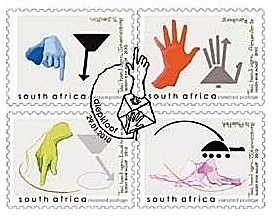As a method of payment for transfer of information, stamps have a strictly utilitarian function. As miniature works of art, they also have an aesthetic appeal. As collectible objects, they can reach prices many times over their face denomination. There is another, often ignored, but just as important aspect of stamps: their role as a visual propaganda, or, to put it in a more benign light, as “little ambassadors”. Stamps are printed by countries and reflect (with more or less success) the official image the country in question wants to present about itself at a specific point in time. So, what is the picture that the stamps of the new South Africa project about the country after the first democratic elections, held in 1994? The first stamps released in the post-apartheid era celebrate unity, with issues such as Peace and Our Family, both featuring children’s drawings. | | The country’s first universal vote elections are celebrated with the series called Freedom Day. Reflecting the new identity of the country, new images appear on the stamps: the new national flag, the new anthem and, of course, the new, first democratically elected president, Nelson Mandela. Changes are noticeable in non-political areas too. Since 1994, stamps depicting art are less likely to feature European-style oil paintings and more likely to showcase traditional crafts and African art, like the Wall Art and the Rare Musical Instruments issues, or the stamps illustrating beadwork. In 2012, the Post Office issued a collection of ten stamps to celebrate 100 years from the birth of George Pemba, a black artist who, against all odds, produced paintings that incorporate the Western artistic tradition during the darkest days of the apartheid. | | Among the stamps that ostensibly fit in with the objective of fostering a new national identity one could also include the Nobel Laureates issue, as well as stamps featuring “common folk” like The Life of Fisher Folk set of ten stamps. The Taxi Hand Signs could be interesting not only for collectors, but also for sociologists, as a reflection of evolving culture: South Africans have developed an array of hand signals to communicate quickly and efficiently with drivers of minibuses, a kind of semi-formal public transport used by the majority of commuters. Among many other post-1994 stamp issues that are likely to catch the attention of collectors are the 150 Years of South African Railways, the 2010 FIFA Soccer World Cup issues, Sport Stadiums (some of them built for the 2010 championship), Bridging the Digital Divide, etc.The series South African Role in Astronomy has been especially praised for its intricate artwork. According to some, the MTN Gladiators series is the first South African stamp made as a commercial advertisement, to promote one of South African cell phone carriers. Through all the changes and upheavals, one area, enormously popular with the philatelists, has remained a constant feature in South African stamps: the country’s rich flora and fauna. Some of the numerous nature issues that deserve a mention are African Wild Cats, Commercial and Medical Plants, The South African Bats, Frogs of South Africa, The Baby Big Five, and so on. |

